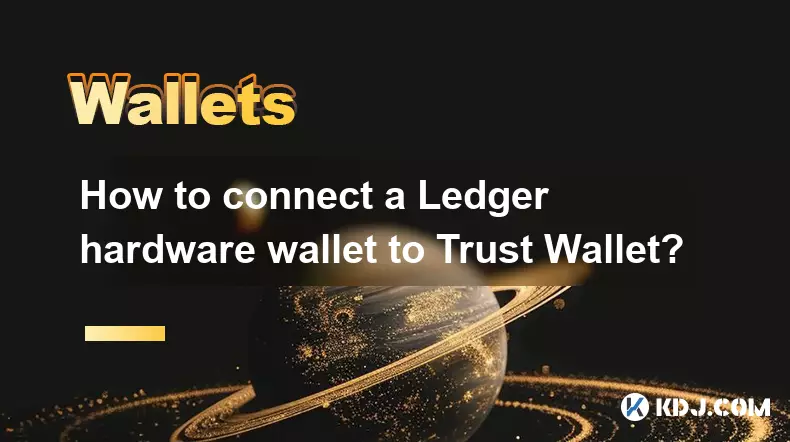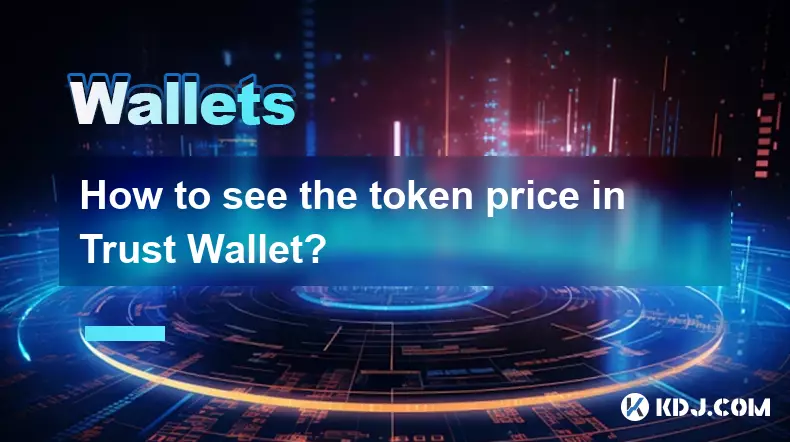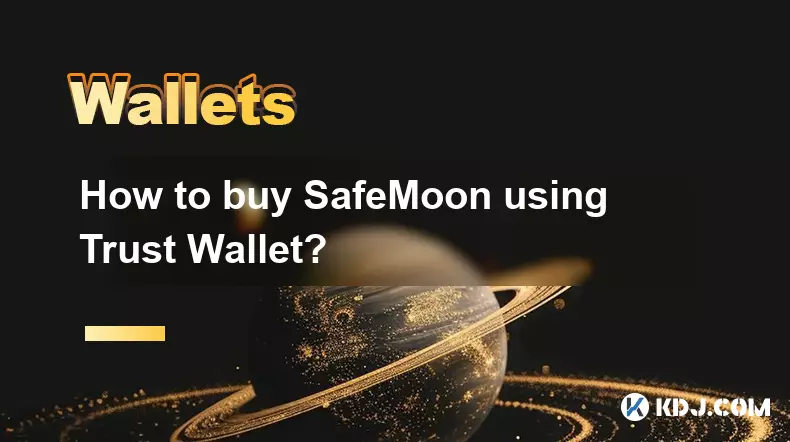-
 bitcoin
bitcoin $99177.955738 USD
-7.32% -
 ethereum
ethereum $3187.183061 USD
-12.38% -
 tether
tether $0.999809 USD
0.00% -
 xrp
xrp $2.117933 USD
-9.42% -
 bnb
bnb $906.710033 USD
-9.17% -
 solana
solana $149.367737 USD
-10.74% -
 usd-coin
usd-coin $0.999816 USD
0.01% -
 tron
tron $0.281498 USD
-0.38% -
 dogecoin
dogecoin $0.156292 USD
-8.00% -
 cardano
cardano $0.500744 USD
-10.19% -
 hyperliquid
hyperliquid $38.087358 USD
-4.58% -
 chainlink
chainlink $14.097831 USD
-8.54% -
 bitcoin-cash
bitcoin-cash $463.329916 USD
-9.22% -
 ethena-usde
ethena-usde $0.999078 USD
-0.01% -
 unus-sed-leo
unus-sed-leo $9.475862 USD
-0.79%
Trust Wallet Security Best Practices: A Complete Checklist
Trust Wallet ensures security through non-custodial design, biometric access, open-source transparency, and phishing detection—keeping your crypto safe when used responsibly.
Nov 05, 2025 at 03:50 pm

Understanding Trust Wallet's Core Security Features
1. Trust Wallet is a non-custodial cryptocurrency wallet, meaning users retain full control over their private keys. These keys are stored locally on the user’s device and never transmitted to external servers. This design eliminates reliance on third parties for fund access.
2. The wallet supports multiple blockchain networks and thousands of tokens, but its security model remains consistent across all assets. Each transaction requires explicit user confirmation, reducing the risk of unauthorized transfers.
3. Biometric authentication such as fingerprint or facial recognition can be enabled to protect wallet access on mobile devices. This adds an additional verification layer beyond just a passcode.
4. Open-source code allows public auditing of Trust Wallet’s functionality. Independent developers and security researchers can inspect the application for vulnerabilities, increasing transparency and trust in its integrity.
5. In-app phishing detection warns users when they attempt to interact with known malicious websites or decentralized applications (dApps). This feature helps prevent credential theft through deceptive interfaces.
Essential Setup and Access Protection Measures
1. Download Trust Wallet exclusively from official sources like the Apple App Store or Google Play Store. Third-party app stores may distribute modified versions containing malware.
2. Immediately after installation, create a strong, unique password that isn’t reused across other platforms. Combine uppercase letters, numbers, and symbols to increase complexity.
3. Write down the recovery phrase during setup and store it offline in a secure location such as a fireproof safe. Never save it digitally—screenshots, cloud storage, or text files are vulnerable to hacking.
4. Enable two-factor authentication where applicable within linked services. While Trust Wallet itself does not offer 2FA, associated exchanges or dApps might, enhancing overall account safety.
5. Disable screen recording and screenshots within the device settings when using the wallet. Some smartphones allow apps to capture screen content, which could expose sensitive data like seed phrases.
Safe Transaction and Interaction Guidelines
1. Always verify contract addresses before approving token swaps or interactions with dApps. Fake tokens often mimic legitimate ones but lead to irreversible fund loss.
2. Review every transaction detail carefully, including gas fees, recipient address, and token amount. Malicious scripts can alter these fields during approval processes.
3. Reject unsolicited requests for your recovery phrase under any circumstance. Legitimate support teams will never ask for this information.4. Limit permissions granted to connected dApps. Revoke access to smart contracts once they’re no longer needed to minimize exposure to potential exploits.
5. Use hardware wallet integration if available. Linking Trust Wallet with compatible hardware devices adds an extra layer of protection by isolating key signing operations.
Device and Environment Safety Protocols
1. Keep the operating system and Trust Wallet app updated to benefit from the latest security patches. Outdated software often contains unpatched vulnerabilities exploited by attackers.
2. Avoid using public Wi-Fi networks when accessing the wallet. Unsecured connections make it easier for hackers to intercept data or inject malicious code.
3. Install reputable antivirus and anti-malware software on the device. Regular scans help detect and remove threats that could compromise wallet integrity.
4. Restrict app permissions to only what’s necessary. For example, deny camera access unless actively scanning QR codes to reduce attack vectors.
5. Consider using a dedicated device solely for cryptocurrency activities. This minimizes exposure to risky downloads or browsing habits that could introduce malware.
Frequently Asked Questions
What should I do if I accidentally share my recovery phrase?Immediately transfer all funds to a new wallet created on a clean device. Assume the compromised wallet is no longer secure. Generate a fresh recovery phrase and safeguard it according to best practices.
Can Trust Wallet be hacked remotely?Remote hacking is highly unlikely if the device itself is secure. Since private keys are stored locally and the app doesn’t transmit them, compromising the wallet typically requires physical access or malware infection.
Is it safe to use Trust Wallet on rooted or jailbroken devices?No. Rooted or jailbroken devices bypass built-in security mechanisms, making them more susceptible to malware that can steal wallet data. Using Trust Wallet on such devices significantly increases risk.
How can I verify a dApp connection request is legitimate?Cross-check the dApp’s domain name against its official website. Look for HTTPS encryption and research the project through trusted community channels before confirming any connection.
Disclaimer:info@kdj.com
The information provided is not trading advice. kdj.com does not assume any responsibility for any investments made based on the information provided in this article. Cryptocurrencies are highly volatile and it is highly recommended that you invest with caution after thorough research!
If you believe that the content used on this website infringes your copyright, please contact us immediately (info@kdj.com) and we will delete it promptly.
- Token Security, Startups, and 2025: A New Era of AI Security
- 2025-11-05 23:00:01
- AI-Powered Ascent: S&P 500 Valuations in the Age of Artificial Intelligence
- 2025-11-05 22:50:02
- Ukraine Ditches the Kopeck: A Symbolic Break from Russia
- 2025-11-05 20:45:01
- StarX Network vs. Pi Network: The Crypto Revolution Heats Up!
- 2025-11-05 20:45:01
- ChatGPT's Meme Coin Pick: Why Noomez Presale is Turning Heads
- 2025-11-05 20:55:01
- Pi Network's Crypto Power: 100 Million Downloads and Beyond
- 2025-11-05 21:05:02
Related knowledge

What is dusting attack and how to protect your Trust Wallet?
Nov 05,2025 at 10:39pm
Understanding Dusting Attacks in the Cryptocurrency Space1. A dusting attack occurs when malicious actors send tiny amounts of cryptocurrency, known a...

How to connect a Ledger hardware wallet to Trust Wallet?
Nov 05,2025 at 10:44pm
Understanding Ledger and Trust Wallet Integration1. Ledger hardware wallets are known for their robust security, storing private keys offline to prote...

How to get a transaction hash (TxID) in Trust Wallet?
Nov 05,2025 at 10:30pm
Understanding Transaction Hash (TxID) in Trust Wallet1. A transaction hash, commonly referred to as TxID, is a unique identifier assigned to every blo...

How to see the token price in Trust Wallet?
Nov 05,2025 at 10:35pm
Accessing Token Price Information in Trust Wallet1. Open the Trust Wallet application on your mobile device and navigate to the wallet dashboard where...

How to buy SafeMoon using Trust Wallet?
Nov 05,2025 at 10:14pm
Setting Up Trust Wallet for SafeMoon Purchase1. Download the Trust Wallet application from the official App Store or Google Play to ensure authenticit...

How to use the scanner in Trust Wallet?
Nov 05,2025 at 09:39pm
Understanding the Scanner Feature in Trust Wallet1. The scanner in Trust Wallet is a built-in tool designed to simplify interactions with blockchain a...

What is dusting attack and how to protect your Trust Wallet?
Nov 05,2025 at 10:39pm
Understanding Dusting Attacks in the Cryptocurrency Space1. A dusting attack occurs when malicious actors send tiny amounts of cryptocurrency, known a...

How to connect a Ledger hardware wallet to Trust Wallet?
Nov 05,2025 at 10:44pm
Understanding Ledger and Trust Wallet Integration1. Ledger hardware wallets are known for their robust security, storing private keys offline to prote...

How to get a transaction hash (TxID) in Trust Wallet?
Nov 05,2025 at 10:30pm
Understanding Transaction Hash (TxID) in Trust Wallet1. A transaction hash, commonly referred to as TxID, is a unique identifier assigned to every blo...

How to see the token price in Trust Wallet?
Nov 05,2025 at 10:35pm
Accessing Token Price Information in Trust Wallet1. Open the Trust Wallet application on your mobile device and navigate to the wallet dashboard where...

How to buy SafeMoon using Trust Wallet?
Nov 05,2025 at 10:14pm
Setting Up Trust Wallet for SafeMoon Purchase1. Download the Trust Wallet application from the official App Store or Google Play to ensure authenticit...

How to use the scanner in Trust Wallet?
Nov 05,2025 at 09:39pm
Understanding the Scanner Feature in Trust Wallet1. The scanner in Trust Wallet is a built-in tool designed to simplify interactions with blockchain a...
See all articles










































































